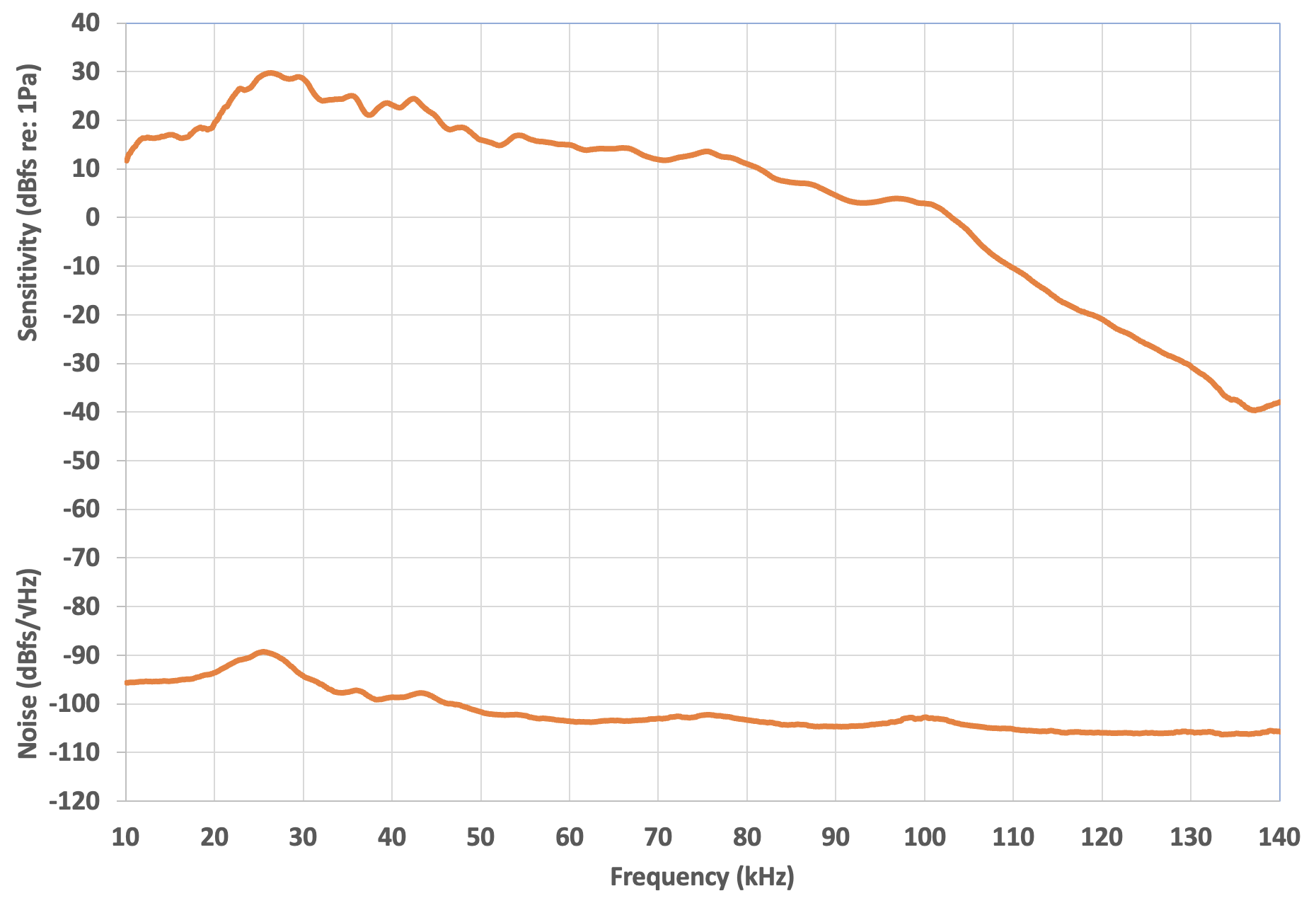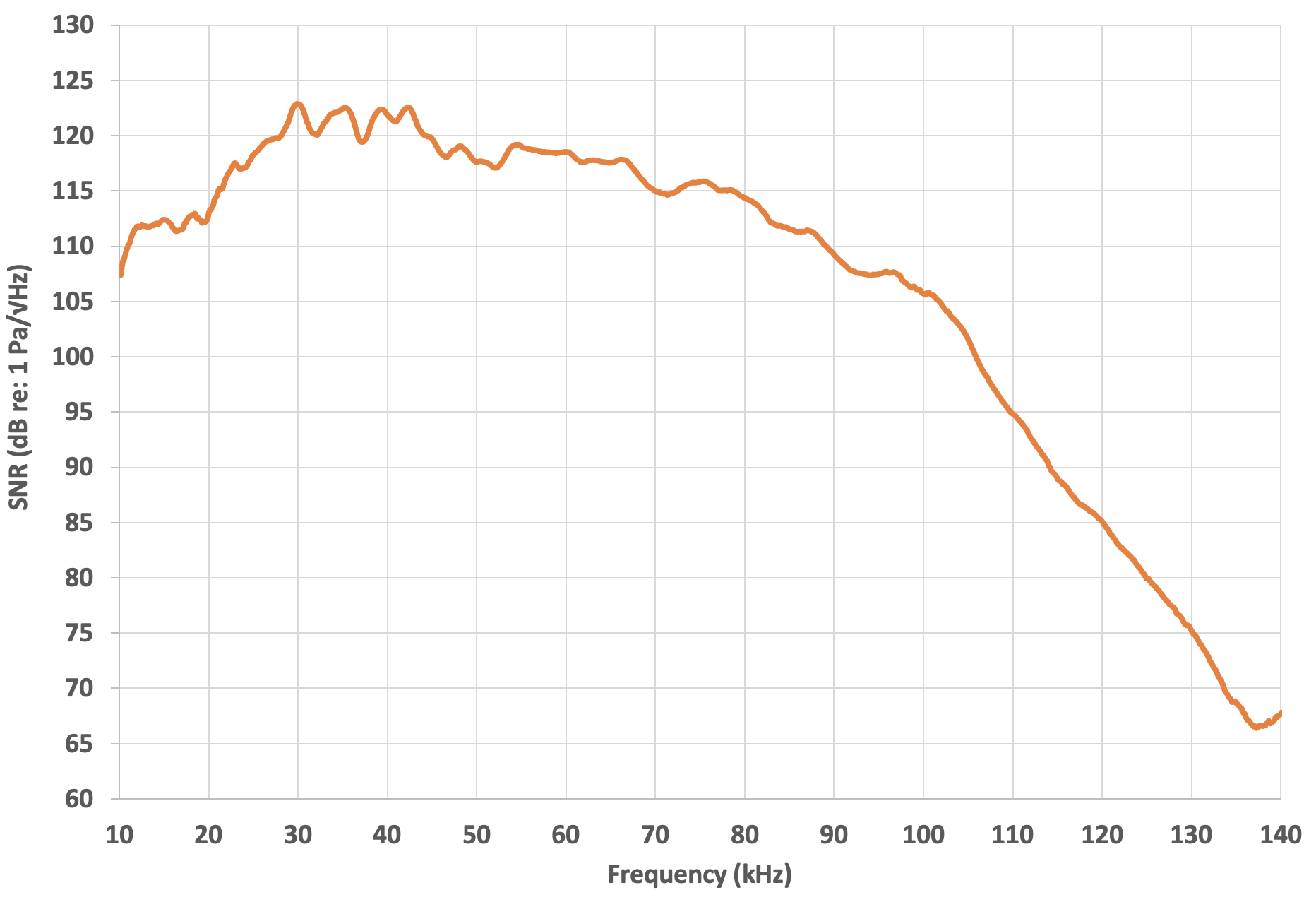11. Specifications
Physical Specifications
Height | 4.7 in. (120 mm) |
Width (with no right microphone) | 5.6 in. (142 mm) |
Depth | 1.6 in. (40 mm) |
Weight with no batteries | AA Version: 0.53 lb. (240 g) Li-ion Version: 0.51 lb. (231 g) |
Weight with max number of batteries (typical) | AA Version: 0.93 lb. (424 g) Li-ion Version: 1.14 lb. (517 g) |
Enclosure Material | Polycarbonate |
Environmental Specifications | IP67 Rated, excluding acoustic microphones Built-in reusable humidity control pack |
Operating Temperature Range | -4°F to 185°F (-20°C to 85°C) Batteries may have a narrower operating temperature range. |
Audio and Microphone Specifications
Ultrasonic Microphone Specifications
All measurements taken with default gain settings, unless otherwise stated.
 |
 |
 |
 |
Directional Characteristic: Omnidirectional
On-Axis Sensitivity: +12 ± 4 dB FS re: 1 Pa at 1 kHz, measured at 18 dB gain setting
The following charts reflect default gain (+18 dB), 48 kHz sample rate, calibrated sound source one meter from the recorder, perpendicular to microphone axis.
 |
 |
Batteries and Power
Types of AA Batteries
AA batteries are available in several distinct categories:
Alkaline: This is the standard, single-use battery. When using AA batteries, the Song Meter Configurator app's battery life estimations assume this type of battery.
Nickel-metal hydride (NiMH): This is the most common type of rechargeable AA battery. A single use-cycle of NiMH batteries will last between 50% and 70% as long as a set of alkaline batteries.
Lithium/iron disulfide, sold as Energizer® Ultimate LithiumTM: This is a type of single-use battery. At room temperature, and when used with a low-power device like the Song Meter Mini Bat 2, they last slightly longer than typical alkaline batteries.
However, in near-freezing or below-freezing temperatures, Lithium/Iron Disulfide batteries maintain their performance significantly better than alkaline batteries.
Lithium-Ion Battery Requirements
From one to six lithium-ion batteries may be used in any combination of positions in the battery tray.
The redesigned lithium-ion battery compartment in the Song Meter Mini Bat 2 can fit a slightly broader range of lithium-ion batteries than the optional lithium-ion lid accessory for the first-generation Song Meter Mini and Song Meter Mini Bat. Wildlife Acoustics sells high-quality 18650 batteries that are compatible with the first-generation Song Meter Mini and new Song Meter Mini Bat 2 models.
Lithium-ion batteries may be sourced elsewhere. The following requirements must be met:
The batteries must be specified as 18650 lithium-ion batteries.
“18650” describes the dimensions of the battery. Larger or smaller lithium-ion batteries will not fit in the battery tray.
Use only protected batteries.
Protected batteries (or protected cells) are assembled with circuitry that prevents the battery from being over-charged or over-discharged.
Danger
Unprotected lithium-ion cells lack protective circuitry, and they are at greater risk of suffering permanent damage or even igniting.
“Button-top” batteries are recommended.
The vast majority of protected 18650 batteries are sold as “button-top,” meaning the positive contact protrudes from one end of the battery. This protruding button ensures the battery makes proper contact with the positive end of the recorder’s battery tray.
The batteries must be between 67.0 and 70.5 mm in length, button included.
The protection circuit can vary in size across brands, but most protected batteries sold by reputable dealers fall within this range.
Note that the Lithium Lid accessory for the first-generation Song Meter Mini Bat has a narrower acceptable size range.
Note
18650 batteries are available in different charge capacities, measured in milliamp-hours, or mAh. The batteries sold by Wildlife Acoustics have a typical capacity of 3500 mAh (3350 mAh minimum). Therefore, the battery life estimates found in our documentation and in the Song Meter Configurator app assume this capacity when using lithium-ion batteries. Protected 18650 batteries with lower capacity will still work, but they will not last as long as these estimates before needing to be recharged.
Power Consumption and Expected Battery Life
The tables in this section display measured power consumption for the Song Meter Mini Bat 2 in various recording modes. All measurements were taken using the same SanDisk® SD card.
Note
SD cards can vary significantly in the amount of power they draw. Two cards of the same model from the same manufacturer will likely have different power requirements. These differences will affect the overall battery life of the recorder.
Battery life duration is estimated based on the nominal energy capacity of high-quality, brand-new alkaline AA batteries or freshly-charged Li-ion batteries. Real-world battery capacity can be altered by factors including ambient temperature. Rechargeable batteries lose their capacity with repeated use, and the rate of this loss is affected by the quality of the charger and the rate of recharge.
Inactive Power Consumption
The Song Meter Mini Bat 2 consumes a small amount of power when turned off and when sleeping during an inactive schedule period. This power consumption is only significant during long deployments with very infrequent recording periods.
State | Power Consumption (mW) |
|---|---|
Off | 0.7 |
Sleeping | 2 |
Acoustic Recording Power Consumption
Power consumption measurements taken using a single SanDisk® 256 GB Extreme 180 MB/s SD card. Power consumption can vary significantly between cards, even among those with similar labels from a single manufacturer.
Sample Rate (Hz) | Highest Quality Mode Power (mW) | Low-Power Mode Power (mW) |
|---|---|---|
8,000 | 66 | 45 |
12,000 | 69 | 48 |
16,000 | 78 | 51 |
22,050 | 71 | 67 |
24,000 | 74 | 56 |
32,000 | 85 | 63 |
44,100 | 82 | 70 |
48,000 | 84 | 74 |
96,000 | 103 | 93 |
Battery Configuration | Highest Quality Mode Recording Time (Hours) | Low-Power Mode Recording Time (Hours) |
|---|---|---|
8x Alkaline AA | 420 | 530 |
6x Lithium-Ion | 1,040 | 1,330 |
Ultrasonic Recording Power Consumption
Power consumption measurements taken using a single SanDisk® 256 GB Extreme 180 MB/s SD card. Power consumption can vary significantly between cards, even among those with similar labels from a single manufacturer.
Sample Rate (kHz) | Armed Power (mW) | Triggered Power (mW) |
|---|---|---|
256 | 47 | 189 |
384 | 51 | 209 |
500 | 59 | 228 |
Battery Configuration | Deployment Length (Nights) |
|---|---|
8x Alkaline AA | 50 |
6x Lithium-Ion | 125 |
SD Card Compatibility
SD Card Capacity Range: 4 GB - 2 TB
The Song Meter Mini Bat 2 supports SDHC and SDXC cards. These two formats encompass SD cards between 4 GB and 2 TB in capacity. We recommend SanDisk® cards as the first choice, but other major brands from a reliable electronics retailer will also work.
MicroSD cards can be used when installed in a microSD-to-SD adapter. We recommend using an adapter from a major SD card manufacturer.
Beware Counterfeit SD Cards!
Large, online marketplaces that allow third-party sellers may include listings for counterfeit SD cards, which are likely to have misleading specifications and may lead to data loss.
We recommend buying SD cards from a reputable electronics or photography supply retailer.
SD Card Speed
Minimum Speed Class: C4 (4 MB/s)
Modern SD cards and microSD cards are designed to handle the output of video cameras, which may be writing over 100 frames of high-resolution video to the card each second. By those standards, the data throughput requirements for audio recording are tiny, even when recording on two channels or at the high sample rates required for recording bats.
SD cards and microSD cards are marked with speed classes that indicate the card's minimum sustained write speed. The minimum speed class required by the Song Meter Mini Bat 2 is C4, meaning a minimum sustained write speed of 4 MB/s.
The Song Meter Mini Bat 2 gains no benefit from faster cards, though backing up files to your computer may be faster.
SD Card Power Consumption
SD Cards and microSD cards can vary significantly in power consumption, even among cards manufactured by the same company and sold under the same product line. These variations can affect the battery life of the Song Meter Mini Bat 2.
As a general trend, SD Cards with lower speed classes tend to draw less power than faster cards.
Bluetooth Specifications
Supported Bluetooth Technology | Bluetooth Low Energy (BLE) 4.2 |